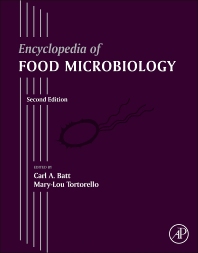Books in Food and health
Books in Food and health
- 1st Edition
- June 5, 2014
- Peter Koehler + 2 more
- English
- Hardback9 7 8 0 1 2 4 2 0 2 2 0 7
- eBook9 7 8 0 1 2 7 9 9 9 2 6 5

Celiac Disease and Gluten
- 2nd Edition
- April 2, 2014
- Richard K. Robinson + 1 more
- English
- Hardback9 7 8 0 1 2 3 8 4 7 3 0 0
- eBook9 7 8 0 1 2 3 8 4 7 3 3 1

Encyclopedia of Food Microbiology
- 2nd Edition
- April 2, 2014
- Richard K. Robinson + 1 more
- English
- Hardback9 7 8 0 1 2 3 8 4 7 3 0 0
- eBook9 7 8 0 1 2 3 8 4 7 3 3 1

Encyclopedia of Food Microbiology
- 1st Edition
- April 1, 2014
- Victor R Preedy
- English
- Hardback9 7 8 0 1 2 4 0 1 7 1 7 7
- eBook9 7 8 0 1 2 4 0 4 6 0 6 1

Handbook of Nutrition, Diet, and the Eye
- 1st Edition
- March 24, 2014
- Mike Boland + 2 more
- English
- Hardback9 7 8 0 1 2 4 0 4 6 1 0 8
- eBook9 7 8 0 1 2 4 0 4 6 8 5 6

Food Structures, Digestion and Health
- 1st Edition
- January 22, 2014
- Ronald Ross Watson + 2 more
- English
- Hardback9 7 8 0 1 2 4 0 1 7 1 6 0
- eBook9 7 8 0 1 2 4 0 4 6 0 4 7

Wheat and Rice in Disease Prevention and Health
- 1st Edition
- September 30, 2013
- John E Blundell + 1 more
- English
- Hardback9 7 8 0 8 5 7 0 9 5 4 3 5
- eBook9 7 8 0 8 5 7 0 9 8 7 1 9

Satiation, Satiety and the Control of Food Intake
- 1st Edition
- September 3, 2013
- Erwin Pulay
- English
- eBook9 7 8 1 4 8 3 2 8 2 8 4 8

Nutrition and Victory
- 3rd Edition
- December 28, 2012
- English
- eBook9 7 8 0 1 2 3 8 4 8 8 5 7

Encyclopedia of Human Nutrition
- 3rd Edition
- December 28, 2012
- English
- eBook9 7 8 0 1 2 3 8 4 8 8 5 7
